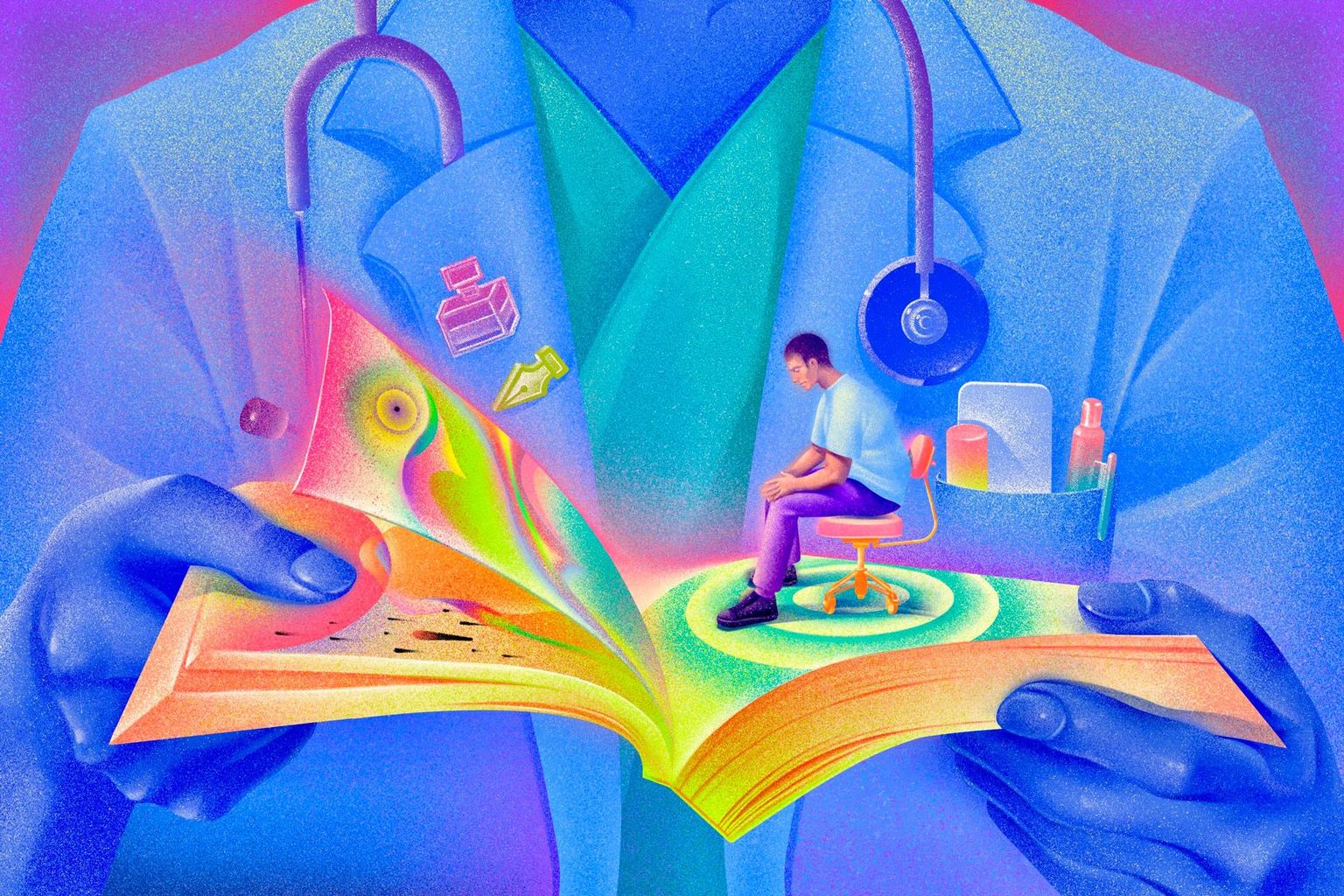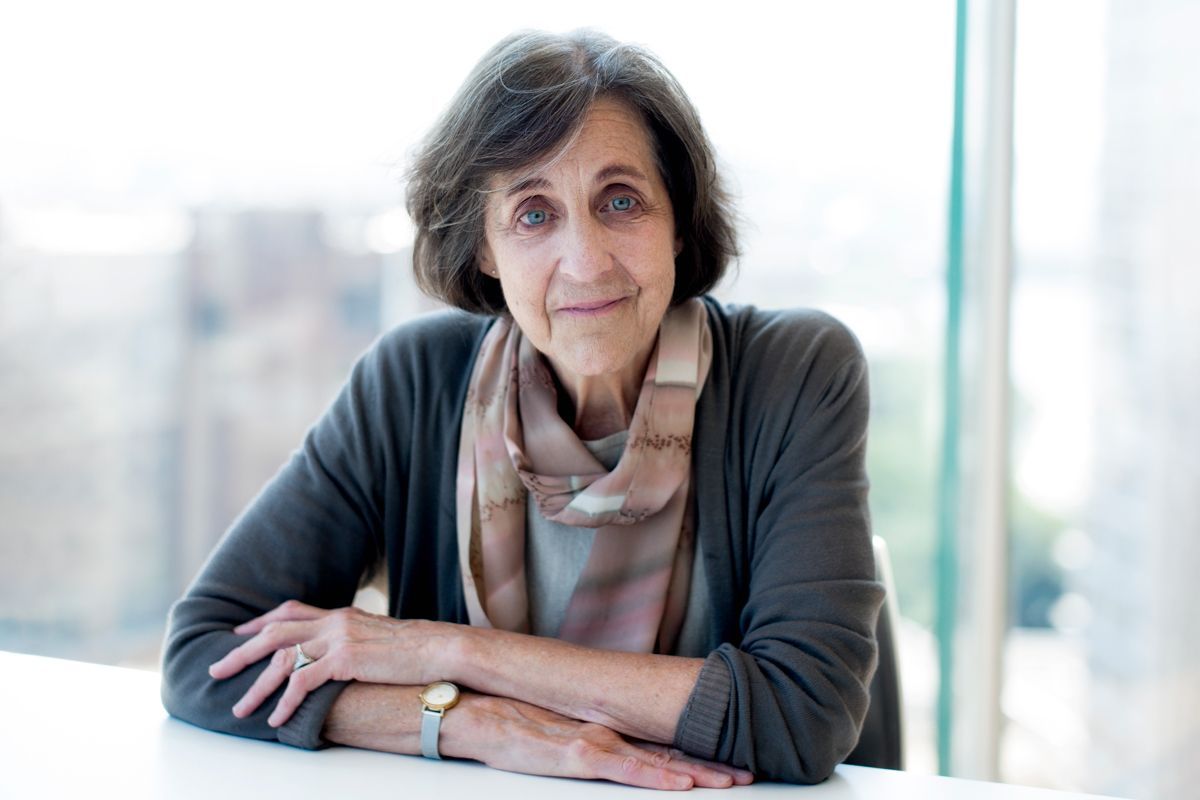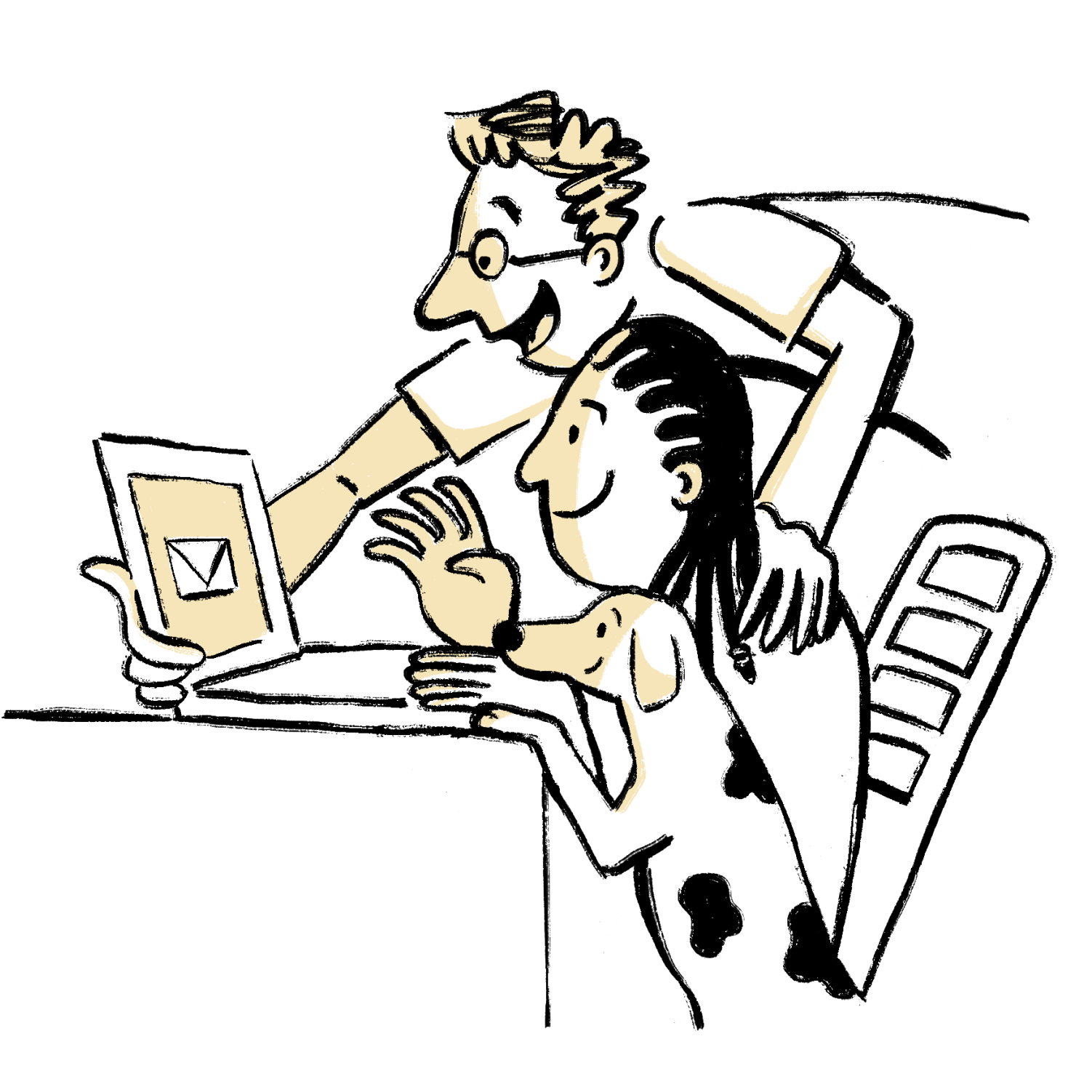Why doctors are turning to fiction to heal their patients—and themselves
In hospitals across the world, doctors are putting down their scalpels and picking up novels to better understand the sick.

Illustration by Wenjing Yang
I was 11 when I fell, suddenly and irrevocably, into the medical system. A fist-sized osteogenic sarcoma growing out the back of my left knee. Common enough, as far as childhood cancers go, but ruinous in its effect, with impacts that are still felt (in the most literal sense) 25 years on.
Since that day an expanding network of specialists, surgeons, physios and nurses have navigated their way across my body, some with gentle touches, some with breaking hammer blows. Some became close to friends, others passed briskly by, their care expressed in sheer technical competence. When a new doctor asks me to narrate my medical history, my reply is usually “How much time have you got?”.
Being doctors, the answer is usually “not much”. Over time I’ve learned to reduce my history down to its most descriptive elements: “ ’97, sarcoma, L knee. Surgery, chemo. ’07, sarcoma, R shoulder. Chemo, radio. ’09, recurrence, L lung. Surgery.” So much contained in so little. Is a person still recognisable in such dot-point haiku?
Our medical histories are a vital part of who we are, the concatenation of event and misadventure that dictates much of the comfort, ease and confidence with which we experience the world. They fold in and around the lives we build for ourselves, inescapable and intimate, the embodied parts of our personal narrative; stories literally written on the body.
The modern medical system that facilitates these stories is a brilliant and atomised thing. Miraculous machines break us into smaller and smaller fragments, unleashing improbable understandings and ever more refined treatments. More people survive their ailments—and survive better—than at any time in human history.
Yet our perception of this care has, perhaps, never been worse. We feel ignored and belittled. We see ourselves as powerless units in an unfathomable construct, shuttled from doctor to doctor in frequently delayed, gaspingly brief appointments that often leave us more confused than when we walked in the door. Efficiency, we are given to understand, is the system’s overarching concern.
Doctors, too, are feeling the strain. Burnout is rife and rates of depression and suicide are creeping upward. Meanwhile, the intricacies of medical billing push practitioners to focus on treatment over care, transforming patients into an assemblage of parts and problems, each one with a specific code and allotted time.
For Rita Charon, the pioneer of a burgeoning field known as narrative medicine, the solution to these two problems is one and the same: teach doctors to read fiction.
“If there’s any kind of complaint that patients have about their healthcare, it’s that doctors don’t listen to them,” Dr Charon, a professor of medicine at Columbia University, explains. “We’ve been at this now for 20 years, trying to figure out what stops them from listening. Because they’re curious people. They’re curious about people. They didn’t become engineers or geologists.”
The problem, according to Charon, is one of fundamental philosophy. “When you train to be a health professional, you are systematically desensitised from thinking about the person as anything but a body. It becomes an object. The dermatologist looks at rashes, the orthopaedic surgeon looks at joints. But when there’s an illness or a hurt, when there’s a loss, it’s not just felt in your joints. So, what keeps doctors from being curious about what happens to people?” Or to put it another way, why are they such bad listeners?
People tell themselves stories to make sense of their lives. Illnesses disrupt that life—and the story they tell about it.
Charon’s interest in this question grew from a creeping dissatisfaction with the perfunctory nature of her own medical practice. “I emerged from medical school in the late ’70s, at this time when historians and philosophers and theologians and painters were becoming involved and interested in medicine,” she explains. A ravenous reader, Charon gravitated toward these new voices, many of whom were advocating for a more expansive understanding of the doctor-patient relationship.
“I enrolled in a Masters in English, and it just made the medicine make so much sense,” she says. “Almost instantly I started doing things differently with my patients. I stopped asking questions. Instead I’d put my hands in my lap and say, ‘Tell me what you think I should know about you’. And they would.”
Narrative medicine is built on a simple idea: that patients, when given permission and time, will tell you what’s important to them—not just personally, but medically. And just like a novel, the story they’ll tell you about their illness will be filled with plot, character, metaphor, occlusion and all the other enemies of literal meaning. Translating these tales into effective and empathetic clinical care requires something akin to what a literature student might call a “close reading”; doctors listen to their patients’ stories, then perform a careful interpretation of the story’s constituent parts. And as in all good books, it’s the things left unsaid, the moments of ambiguity and uncertainty, that often tell the story.
“When I started talking to patients that way, I learned the things that they really needed, things that I would not have gotten to for months and years,” Charon says. “I would write down what I heard and I’d give it to the patient and say, ‘I think this is what we did today. Did I leave anything out?’ And the patient would read it and they would write back and they would send me things they had written. So, the whole practice became a practice of stories where the stories mattered.” It’s the act of listening, then—zooming in and out on a patient’s full experience of their illness—that matters.
Charon went on to complete her PhD in English at Columbia University, writing her dissertation on her true literary love, Henry James. “James has this incredible capacity to see inside a character and to explain in profound detail what is rolling around this consciousness,” she says. “Every human being that he writes about is so inordinately complex and never-ending. And isn’t that a great thing for a doctor to know? The never-endingness of the people they treat.”
Charon, who is in her seventies, talks in unhurried, elliptical paragraphs, rich with double-backs and unexpected turns, and punctuated with pauses, repetitions and dramatic emphases. In a way serially uncommon to the interviewer’s profession, I feel like we’re actually conversing with one another; listening and responding in a state of reciprocal curiosity.
I find myself telling her about my experiences with cancer at 11 and 22, and about my father, a respiratory physician, who spent his professional life shepherding people towards a good death. She listens, nods, tells me how powerful such struggle has made me, how grateful she is for helping her to understand. We’re a long way from a medical office, but the acknowledgement is unexpectedly affecting.

Rita Charon says doctors find uncertainty hard to deal with, which makes diagnosing complex conditions difficult. "But tolerating uncertainty is one of the things you learn to do if you’re a good reader." Photo: Vincent Ricardel/National Endowment for the Humanities (NEH)
Listening is the fundamental unit of narrative medicine. But the ability to interpret stories, to find the throughline and unearth the subtext, to question assumptions, is what makes it work. For the last two decades, Charon has been teaching doctors to do just that through her Masters of Narrative Medicine at Columbia.
“The purpose of the course is to help doctors to love stories and write them and act them out and delve into them,” she explains. “We teach very complicated novels, hard fiction, heavy-duty Sebald, poetry. We show them the complexities, how a sentence can mean 10 different things.”
“Doctors don’t do well when they don’t know what the problem is,” she adds. “They find uncertainty very hard to tolerate. But tolerating uncertainty is one of the things you learn to do if you’re a good reader, along with taking other perspectives. It’s not just my view of this, but it’s mine and the patient’s and their sister’s and their consultant’s.”
One of the key components of the course is getting the doctors to start writing their own stories. Charon discourages autobiography. “I don’t much care for memoir,” she says. “Plenty of doctors have already told us their stories from a life in medicine. I want to know: what surprised you today? What did you see today that you had never seen before? What was a mystery today? Write about that, share it, read it to the class and you start to realise that you can see things that other people might not see.”
While some in the medical fraternity have met Charon’s ideas with scepticism (unsurprising, perhaps, for a profession raised on reference books and the scientific method), plenty more have embraced them with both hands; narrative medicine is currently taught, in one form or another, at about 80 per cent of medical schools in the US, and its footprint in Australia is growing rapidly. There’s also a growing body of evidence that the practice leads to better patient outcomes. A wide-ranging 2016 meta-analysis found that patients treated within a narrative medicine framework had decreased levels of pain and an increased sense of control and well-being, while doctors who received narrative medicine training felt they were able to empathise and communicate with patients more effectively.
Among the many reasons why narrative medicine appears to work, perhaps the most interesting has to do with something known as ‘biographical disruption’. According to this theory, people tell themselves stories to make sense of their lives. Illnesses constitute a disruption to that life—and to the story they tell about it. By incorporating the illness into their life narrative, a person can effectively patch over the split that the illness introduced. Viewed this way, narrative medicine is akin to psychotherapy: it heals through a process of meaning-making.
But Charon is adamant that it’s more than just a tool for improving the lot of patients—it’s also a way of saving the practitioners themselves. “Stories make communities. Doctors and nurses right now are disillusioned, they’re burnt-out, they’re giving up. They feel alone. But when they tell stories, they have a listener, they have peers, colleagues, people to go through this with them. And that isolation lifts.”
As in all good books, it’s the things left unsaid, the moments of ambiguity and uncertainty, that often tell the story.
Charon tells me about a project she led where she brought oncologists and cancer patients together in a monthly writing group. “The patients would read what they’d written and the doctors would say, ‘I didn’t know that was happening. My patients never tell me that kind of stuff.’ And the patients would hear what the doctors wrote and say, ‘You mean my doctor thinks about me when I’m not in the office? You mean my doctor mourns when I die?’ Of course! We’re all human. There need not be such a damn gulf between us!” Charon pounds the table in emphasis.
“It is hard though,” she continues, thoughtful. “The more you know about the lives of patients, the harder it is to see them suffer, and the harder it is, toward the end, to care for those you don’t want to lose.” (About her surname, which she shares with the ferryman of the dead in Greek mythology, Charon says, “It’s a name to live up to.")
Time is the enemy of the medical practitioner. Patients running out of time. Appointments running over. The need to make each minute bureaucratically meaningful. It’s fair to ask exactly how doctors and nurses and physios and everyone else who ushers patients through our creaking medical system are supposed to open themselves to the meandering tales of the people they treat.
“I’d just say that it’s really easy to do experiments,” says Charon. She tells the story of a medical student who was having trouble talking to patients. “He was constantly interrupting and very intense.” On a ward round, Charon saw him badgering an older woman complaining of chest pains. Charon took him aside and told him to stop barking questions and instead say to her, “Tell me more about that”.
“She was talking about lifting her grandson, and then this doctor said, ‘Tell me more about that,’ and suddenly we hear that it’s her 14-year-old grandson and he’s severely autistic and she’s trying to raise this child by herself. Do you see? That’s what I’d tell these doctors: just for a day, be the kind of doctor who says, ‘Tell me more about that’. You’ll be amazed by what happens.”
